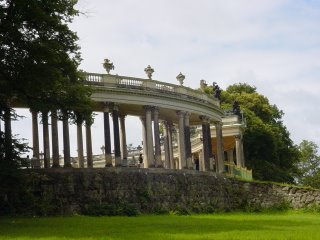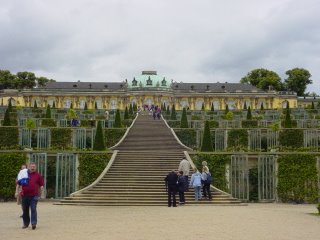the San Soucci Palace
 It was almost noon when I got to San Soucci Palace, but my guide suggested that, due to the attraction’s popularity, it would be best to buy tickets before the afternoon in summer. So I figured on postponing lunch until after the palace tour. As I approached the palace, from outside the gates ,the courtyard looked very much like a Roman coliseum. Sets of marble pillars formed two halves of a circle, and a small stretch of pavement between them connected the beams like a line connecting the dots.
It was almost noon when I got to San Soucci Palace, but my guide suggested that, due to the attraction’s popularity, it would be best to buy tickets before the afternoon in summer. So I figured on postponing lunch until after the palace tour. As I approached the palace, from outside the gates ,the courtyard looked very much like a Roman coliseum. Sets of marble pillars formed two halves of a circle, and a small stretch of pavement between them connected the beams like a line connecting the dots. From the street, it looked both impressive and offered a refreshing change from the structure of many other grand buildings I had seen recently. A I walked higher up the hill and the Palace came into view, I was surprised at how small it seemed. The whole thing looked to be about the size I’d expect of a mansion. Unlike most mansions, though, the building also seemed to be made of white marble, with the center of the building capped with a large green metal dome. What looked to be a coliseum structure from the road proved not to be bowl-like in its interior, but completely flat.
The line I stood in for tickets was not a short one, but I did get it eventually, albeit expensively in spite of my student discount. But as with everything expensive but worth seeing on this trip, I had to assure myself that the price was really not all bad considering the experience it would provide me.
It was worth it. Though the palace was small, it’s architect, Fredrick I, certainly had a sense of style. In able to be allowed inside the palace for a tour, we were made to put on these huge, thick wool slippers over our shoes, so as to be gentle on the floor. No one else on the tour seemed to have a problem with them, but they drove me insane. Maybe it’s the way I walk, but the damned things kept going crooked on my feet, no matter how frequently I straightened them. But that is neither here nor there.
Fredrick I built his palace in the Rocco tradition. As neither art nor architecture has ever meant very much to me, let me explain why I care. A feature of Rocco style is that the room does not achieve magnificence through containing great pieces of art. Rather, the room itself is a piece of art. Thus, the overall visual appeal of the room was far more important to its design than was the comfort the room offered, or the practicality of the rooms use. For instance, one hallway boasted very ornate couches, the seats of which were far too thin in width to actually have a person comfortably sit on them without slipping off.
By extension of this philosophy, if the entire room was to be the piece of art, the room must refrain from containing any centerpiece as that would attract too much singular attention to one portion of the palace. You see, people cannot look at a statue and think “what a room to put this piece of art in!” The pieces must add to the epic nature of the room without competing for it. The room itself must be the piece of art, and thus uphold a sense of unity. Having any central focus to the room would fragment that unity.
So in each room there was not one, but dozens of pieces of impressive art or furniture. There was never just one picture on the wall, the wall had to be tiled with them. There could never be a singular sculpture, there were always several scattered around the room. And to tie everything together, Fredrick was very liberal in his use of gold paint. The stuff was everywhere – twisting and crawling up the walls in various patterns, often meeting on the ceiling in one swirling mass. It was so blunt a tactic as to be quite gaudy, but such is Rocco style.
The overall effect of the room was actually somewhat dizzying if you tried to focus on it. You are standing in a piece or art, in a room where the entire contents are eye-catching no piece could outbid the other to catch the eye.
Not every room was done in this style, however. When Fredrick I died, his nephew became king and he had several parts of the building redone. Judging from the results, I’d disagree with the decision. But one of the extensions, the Voltaire room (King Fredrick was good friends with Voltaire, who evidently stayed in the palace on several occasions), was redone in a very different, if somehow impressive, theme.
The room brings 3-dimensional artwork to the world of wallpaper, with 3-dimensional vines spouted from the wallpaper and crept up the walls. Scattered along these vines were parrots that likewise sprung from the paper.
I cannot be sure what the artist did to make this room, but the parrots did cast the illusion of being separate from the wall, even as many of their bodies protruded only slightly from the wall. While I enjoyed these parrots, my favorites were the 5 herons. Some looked serene, others agitated, and they gave no illusion of being separate from the wall as the parrots did. But I’m a sucker for the grace of a heron.

0 Comments:
Post a Comment
<< Home